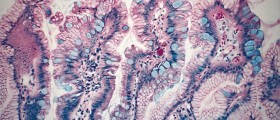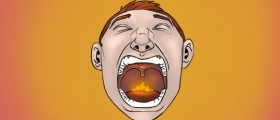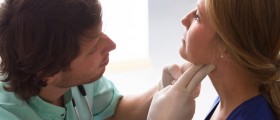Esophagus is the organ in the form of a tube that connects the oral cavity and the stomach. It is of a muscular structure and, along with the throat, it plays a big role in the process of eating, serving as the passage for the chewed contents to the digestive system. The muscles of the esophagus contract to push down the food and drinks to the stomach.
Symptoms
When the sense of burning is felt in those areas, it is, in fact, the common sign of inflammation. But, this condition is not the same thing as a sore throat; while the burning throat is marked by an ardent and intense pain sore throat is associated with the pain at the base of the tongue (fauces and tonsils are affected) and pharynx (the tube which connects the esophagus to the nasal cavity).

So, the burning in the throat and esophagus is not as usual as sore throat, but the causes are the same because this condition can be the consequence of the spreading of the inflammatory process from sore throat. Those triggers are the inflammation of the tonsils an infection caused by bacteria (most frequently by streptococci), and the lack of moisture in the throat.
Causes
But, this condition happens most usually because of the infection of the esophagus since it is very possible to introduce a lot of unwanted substances when eating, for example. One could provoke this ardent pain when consuming some foods or drinks that simply irritate the membranes of the esophagus such as cold alcohol drinks or very spicy and hot foods. But in those cases the pain will not last for a long time and the inflammation almost certainly won’t happen.
But, the inflammation of the esophagus can be triggered by overeating and by not chewing the food enough, too. This is the condition called heartburn, and it often leads to the inflammatory process. Especially uncomfortable is the rising of the acid in the stomach up to the throat.
- In some people, stomach contents regularly leak into their food pipe, or a relatively large amount leaks out. It is considered to be GERD if this causes frequent or severe heartburn or acid reflux that affects your quality of life, or if your food pipe has become inflamed.
- The food pipe becomes narrower just before it reaches the stomach. This narrow part is normally kept shut by the muscles in the food pipe and diaphragm. But this doesn't work properly in GERD. It is often not clear why.
- In some people it is caused by a hiatal hernia (also known as a hiatus hernia). The diaphragm is a sheet of muscle that separates the chest and abdominal cavities from each other. The food pipe passes through a small hole in the diaphragm and enters the stomach just below it. In people who have a hiatal hernia, the upper part of the stomach pushes up through the hole in the diaphragm and into the chest cavity. As a result, the diaphragm can no longer help to close the entrance to the stomach.
- A lot of people who have reflux and heartburn worry about the possible health consequences. But it usually doesn't get worse. Sometimes reflux can lead to changes in the mucous membranes lining the lower end of the food pipe. This is known as “Barrett’s esophagus.” It is estimated that 5 out of 100 people who have reflux will develop this condition after some time.
- GERD can usually be diagnosed based on typical symptoms. It is therefore important to describe your symptoms to your doctor in as much detail as possible, and tell him or her when and how often they occur. If someone is thought to have GERD, doctors sometimes suggest that they have a “trial treatment” known as a PPI test to see if they respond. The test involves taking proton pump inhibitors (PPIs) for about two weeks. If the medication relieves the symptoms, then it is very likely that GERD is causing them.
So, as far as the treatment is concerned, in the cases of stomach acid rising (which is the most common cause of the inflammation of the esophagus), one should, of course, eat more slowly and carefully and sometimes the medications for calming down the stomach are recommended. In the more severe cases, a surgical procedure must be performed to stop the acid reflux from damaging the esophagus.
That is, cutting off its lining might happen and that can be the cause of some more dangerous conditions since the scar from the cutting could grow into an ulcerous formation, and thus the infection may occur also.
- www.nhs.uk/conditions/heartburn-and-acid-reflux/
- medlineplus.gov/ency/article/000265.htm
- Photo courtesy of U.S. Navy photo by Journalist 1st Class Jeremy L. Wood. by Wikimedia Commons: commons.wikimedia.org/wiki/File:US_Navy_040113-N-4614W-005_Capt._Wan_Mun_Chin_examines_a_patient_suffering_from_a_sore_throat_and_high_fever.jpg

















Your thoughts on this
Loading...